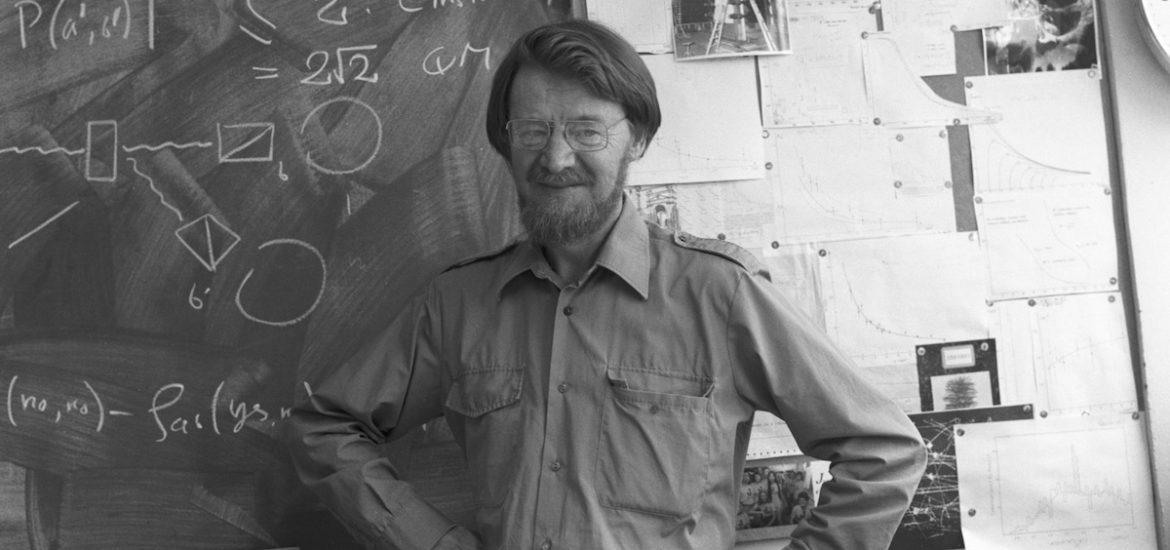Quantum mechanics has baffled scientists for decades. One of its strangest predictions? Particles can instantly affect each other across vast distances—what Einstein famously called “spooky action at a distance.” In 1964, physicist John Bell proved this weirdness is real.
Bell’s groundbreaking work, explained in Adam Becker’s What Is Real?, transformed abstract philosophical debates into testable experiments. The results shocked the physics world and confirmed that reality operates in ways far stranger than we’d imagined. Keep reading to learn how Bell’s theorem changed our understanding of the universe.
Image credit: CERN via Wikimedia Commons (License). Image cropped.
Table of Contents
What Is Bell’s Theorem?
Bell’s theorem shows that, if quantum mechanics is correct (and experiments say it is), then reality is fundamentally nonlocal—or at least not governed by any hidden classical mechanism. In his book What Is Real?, astrophysicist Adam Becker explains Bell’s theorem in the context of a broader debate within quantum mechanics.
The Background to the Theorem
Becker lays out a fundamental puzzle: while quantum mechanics describes particles existing in multiple states simultaneously and influencing each other across distances, we don’t observe these strange behaviors in everyday life. When scientists try to measure quantum systems, the quantum properties vanish.
Since the 1920s, physicists have debated where and why the rules transition from quantum to classical behavior. According to Becker, most physicists avoided directly solving this problem by adopting the “Copenhagen interpretation”—which claims nothing has definite properties until observed, so objective reality only exists through observation. This conveniently explains why we don’t see quantum weirdness in daily life.
However, Becker contends the Copenhagen interpretation became dominant, not through rigorous scientific debate, but because alternative explanations were sidelined by political and philosophical influences rather than being fairly evaluated.
Despite decades of institutional hostility, the fundamental questions about quantum mechanics’ meaning proved impossible to eliminate. Becker explains that experimental breakthroughs and theoretical innovations gradually rehabilitated foundational research—and revealed that the same questions troubling Einstein and Schrödinger remained unresolved, creating ongoing tensions about science’s ultimate purpose and the nature of reality itself.
How Bell’s Theorem Transforms Philosophy Into Experiment
The return to these fundamental questions began in 1964 with John Bell, who was skeptical about a mathematical argument that had supposedly proven the Copenhagen interpretation was the only possible approach to quantum mechanics. This argument was John von Neumann’s 1932 “impossibility proof,” which claimed to show that no theory with “hidden variables,” where particles have definite properties before measurement, could reproduce quantum mechanics’ predictions. As Becker notes, this seemed to prove that realist positions such as Einstein’s were mathematically impossible: If particles can’t have definite properties before measurement, then only anti-realist interpretations such as Copenhagen could be correct.
But Bell discovered that von Neumann’s proof was flawed. Bell then reconsidered Einstein’s thought experiment and transformed his philosophical concerns into mathematical tests. Bell reasoned that if particles do have definite properties before measurement, then measurements on entangled particles should obey certain mathematical constraints on how strongly correlated the results can be, which became known as “Bell’s inequalities.” Quantum mechanics predicts that entangled particles will violate these limits, so this gave physicists a decisive test, and experiments in 1972 and 1982 proved that particles violate Bell’s inequalities. This meant Einstein was right about “spooky action at a distance” being real—but wrong about quantum mechanics being incomplete. The theory wasn’t missing information; reality really was nonlocal.
| Why Bell Thought Einstein Was Right to Be Worried For decades, physicists dismissed Einstein’s concerns about quantum mechanics by citing von Neumann’s proof. But the proof contained a fatal flaw: It assumed that hidden variables must behave according to a “linearity” rule that sounds reasonable mathematically but makes no physical sense. Specifically, von Neumann required that if you could measure two quantum properties A and B separately, then you should also be able to measure their mathematical combination (A + B). But in quantum mechanics, many properties can’t be measured simultaneously, so demanding that their combination be measurable is physically meaningless. The experiments that proved particles violate Bell’s inequalities showed that particles do have some form of objective reality—supporting realism—while confirming that “spooky action at a distance” really exists. This supported Einstein’s concerns about quantum mechanics’ disturbing nonlocal implications: Locality is fundamental to our spatial understanding of the world—it lets us identify different locations and treat them as independent. Einstein worried that abandoning locality meant abandoning our framework for understanding cause and effect. Bell’s theorem proved that reality really is as strange as Einstein feared, validating his intuition that such strangeness deserved serious concern rather than casual acceptance. |
Becker explains that Bell’s theorem forced physicists to face a choice: Abandon the principle of locality (and accept the idea of instant connections across space), abandon realism (and accept that properties don’t exist before measurement), or abandon the idea that quantum mechanics is complete. Three alternative interpretations represent different responses to this choice. They all revolve around the question of what causes wave function collapse—the moment when the “probability wave” of a quantum particle’s potential location and momentum “collapses” into the specific characteristics it takes on when it’s observed and measured.
Dive Deeper Into the Issues Surrounding Bell’s Theorem
Becker effectively positions Bell’s work as part of the ongoing debate in quantum mechanics. To learn more about the broader context of the theorem, read Shortform’s full guide to Becker’s book What Is Real?
